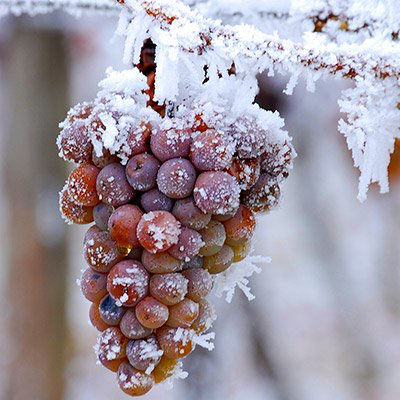Sweet Wine Throwdown
How are Vin Santo, Niagara icewine, and trockenbeerenauslese different?
In WSET on 23 Apr 2017
With my WSET Diploma Unit 3 exam looming in the not-so-distant future, I’ve been practicing writing essays on a variety of wine industry topics, and friends suggested I post them here. The last one was pretty dry, so this seemed necessary.
High-end sweet wine is so incredibly underappreciated among consumers. It’s worlds away from the Cupcake Moscatos and Jam Jars of the world, like a high-end dark chocolate truffle to their Hershey bars, but people don’t expect to pay top dollar for sweet wine because they associate it all with cheapness and low quality. For really good high-end dessert wines, though, you have to be willing to fork over some cash. The reason? Hard labor and low quantity.

Several of the world’s great dessert wines take advantage of fact that as grapes become raisinated they develop concentrated sugars, which leads to an intense flavor. Three, in particular, are illustrative examples of what can happen to a grape on the vine after the regular harvest season winds down.
Produced all over Italy but most prominent in Tuscany, Vin Santo is a dessert wine typically made from trebbiano and malvasia grapes. The grapes are harvested as usual but then laid out on mats or hung from rafters in barns to dry for several months, usually over the course of winter. During this time the grape environment must be kept dry enough to protect the fruit from rot. Once the weather begins to warm up, the grapes are pressed into must and placed in small casks (anywhere from 50 to 200L) to begin fermentation. Contrary to the process in most dry wine styles, the casks for Vin Santo are sealed with concrete (sometimes even with a little of the lees from the last bottled vintage), and left for many months as the temperature causes the fermentation to speed up, stop, then start again, sometimes for several years.
You wouldn’t be wrong to think all this sounds like a bit of a crapshoot. The Vin Santo process is highly variable, and sugar and alcohol content and flavor can range dramatically from producer to producer, region to region, and year to year. One option is to blend vintages to create a more consistent flavor profile; another is to simply know your producers and select from either a high-quality small one or a large, reliable one with the ability to produce high quantity and blend the good stuff while discarding the bad. On the consumer end, good Vin Santo is expensive and selecting one requires a fair amount of knowledge (or trust in your sommelier or salesperson).
Niagara icewine takes advantage of the Niagara, Ontario climate (Niagara County, New York, is just across the river and produces small amounts of its own icewine, though American wine is obviously not VQA-certified), which reliably gets cold enough in the winter for this nectar-sweet dessert wine. Icewine is made from approved grape varieties––usually vidal blanc or riesling, though cabernet franc is also popular––that have been netted in the vineyard since ripening to protect them from being eaten by birds. The grapes are left on the vine till winter to raisinate, the water inside them freezing completely. This requires a sustained temperature of around -8C. Icewine that is botrytis-affected is its own VQA category, either “Botrytis Affected” or “Totally Botrytis Affected” (a cheeky reference to the other kind of TBA, which I’ll get to in a minute).
When picking conditions are optimal––between -10°C and -12°C––the grapes are harvested, usually by hand at night, and pressed slowly to extract the intense juice. The high sugar content can lead to a challenging environment for the yeast, so it’s crucial to monitor fermentation carefully. Some icewine is aged in oak. Due to the hard labor required and the small amounts produced, it’s always pricey, but Niagara has, at least locally, worked hard to market icewine and educate consumers about what makes it worth the cost.
Trockenbeerenauslese (the original TBA) literally means “dried berries selection.” The final stage of Germany’s ripeness-based Prädikatswein classification system, TBA is a tribute to two things: botrytis and, in almost all the best examples, the riesling grape. Unlike with Vin Santo or icewine, botrytis is a salient feature of trockenbeerenauslese wine, and only certain vintages, when even ripening and widespread botrytis affectation combine, are worthy of it. TBA does not require the grapes to be frozen or picked at a certain temperature. As with icewine, the berries are hand-picked and pressed slowly to extract a concentrated sweet juice with very little water. Trockenbeerenauslese is typically not oaked. It is very rare and expensive, since botrytis doesn’t happen on command, and it’s sweet and viscous. TBA is typically found in Germany and the Burgenland region of Austria.
All three of these wines are excellent with Dunbarton blue cheese and a Wheat Thin.